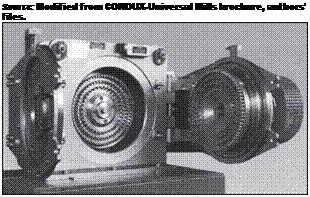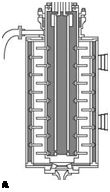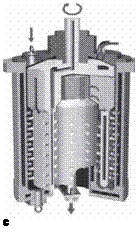After World War II, Netzsch-Feinmahltechnik GmbH, which had been established in Bavaria, Germany, in 1879 by two brothers to design and build machinery for the region’s ceramic industry, took advantage of the rapid postwar recovery to diversify its product range and built processing machines such as filters, mills, and pumps. Its engineers had been investigating stirred mills for fine grinding for some years and had observed that the early vertical mills in which the grinding media were stirred at low speed had regions in which the energy intensity was low, resulting in some particles not being properly broken or dispersed.
In 1963, an agitator peg mill was patented by Willy John of Netzsch that was designed to create high and uniform energy intensity. It consisted of two concentric cylinders with pegs attached to the inner wall of the stationary outer cylinder and the outer surface of the rotating inner cylinder. The high peripheral speed of the inner cylinder and the interacting mixing patterns created by the short pegs provided a uniform energy intensity throughout the breakage zone, and the mill proved to be efficient for high- viscosity and high-solids content materials. It was particularly suitable for the grinding and dispersion of pigments in high-viscosity paint media.
For many years batch ball mills had been used for grinding paints, and long residence times were required. With much smaller balls moving at much higher velocities in the stirred mill, there was the same energy per impact but many more impacts so the work was done much faster. For paint manufacture, the ball sizes are of the order of 3-12 mm and stirrer speeds of the order of 70-400 rpm. High-speed peg mills are also used for mineral grinding, although the balls are larger, because the particles are hard and the products required are coarser. Figure 8.7 shows diagrams of the early “John” peg mill,
|
Condition |
Housing |
Door |
|
Disc diameter, mm |
1,375 |
1,327 |
|
Speed, rpm |
2,200 |
1,200 |
|
Motor, kW |
200 |
132 |
|
Air volume, m3/hr |
17,300 |
|
TABLE 8.1 Operating conditions for a large high-speed pin beater mill |
 |
 |
 |
 |
FIGURE 8.6 Netzsch high-speed mill with pins in discs (Reprinted by permission from Netzsch — Feinmahltechnik)
FIGURE 8.7 Three peg mills: (a) early Netzsch John mill (Netzsch 1974; reprinted by permission from Netzsch-Feinmahltechnik) (b) Sala-SAM mill for ore grinding (Denver Sala Basic 1994; reprinted by permission from Metso Minerals) (c) Drais Mannheim mill for ultrafine grinding (Drais Mannheim 2000; reprinted by permission from Buhler)
the higher-speed Svedala peg mill used for grinding minerals, and two very high-speed mills using very small grinding media for ultrafine grinding.
The media are glass, steel, or ceramic grinding beads in the range of 0.3-1.1 mm in diameter, and the product size is in the submicron range. The mill consists of three concentric cylinders, the inner and outer being fixed and the center rotating at high speed. The mixture containing beads, pigment, and fluid flows from the top down, through the outer high-intensity zone, then up through the inner zone and is centrifuged after the last stator peg is passed. The beads are returned through slots to join the incoming pigment and fluid. The ground product passes through a discharge screen and leaves the mill. This type of mill is used to manufacture liquid inks and toners, ultraviolet blockers, textile dyestuffs, paper-coating liquids, and other materials requiring ultrafine particles.
